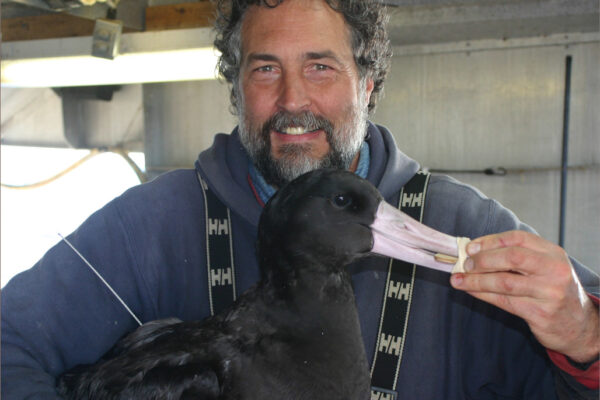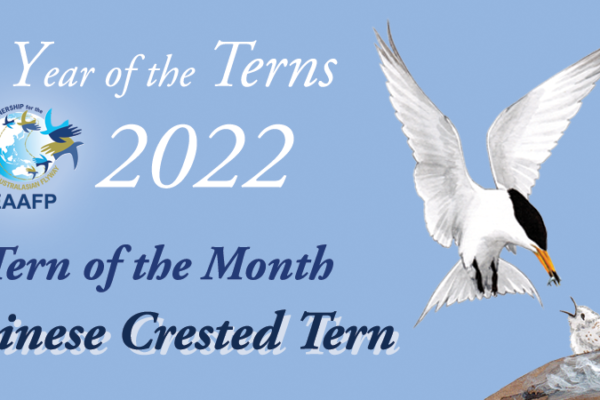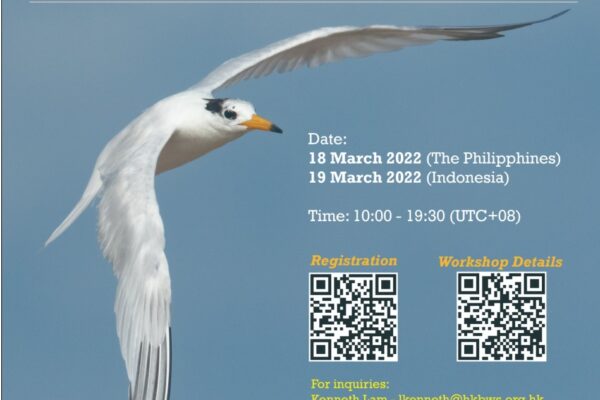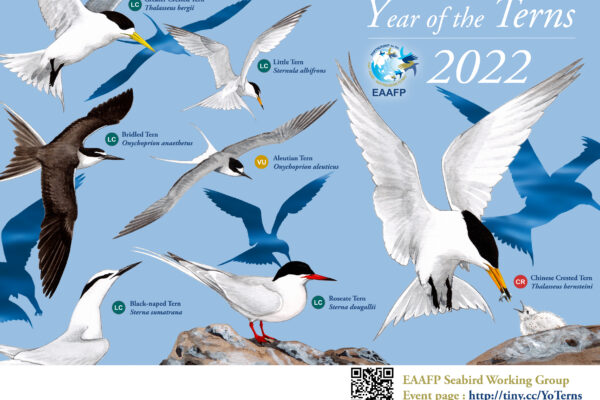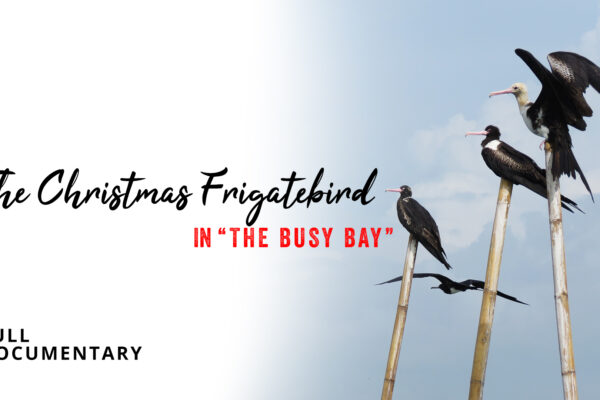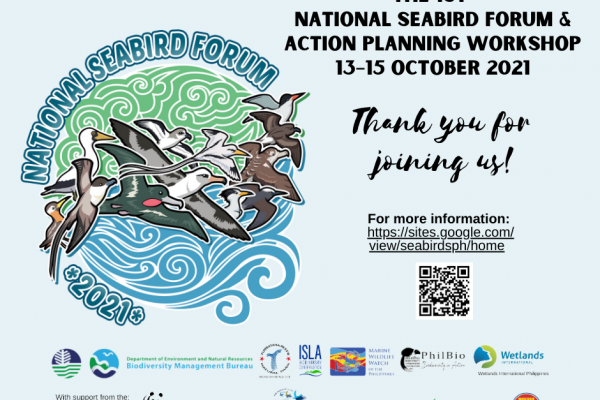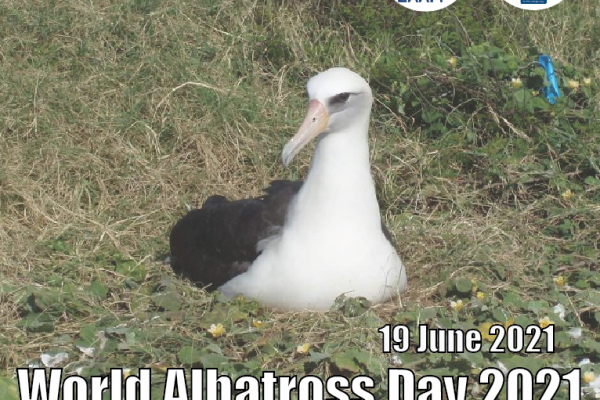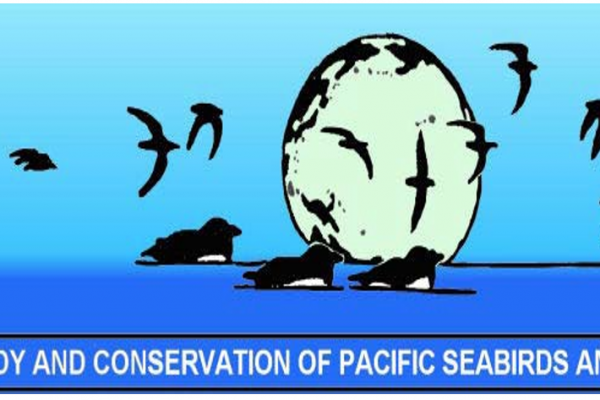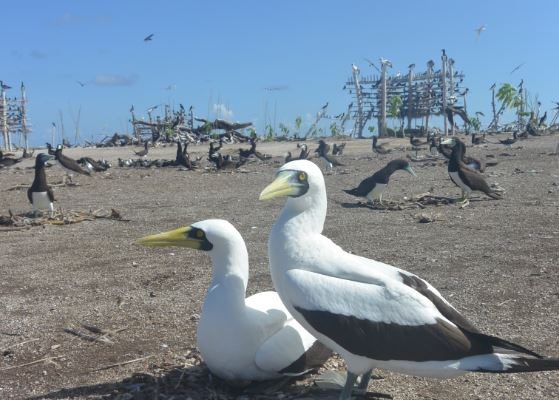-
“Year of the Terns” Flyway Story Series #16 – Prof. Daniel Roby, Seabird researcher and conservationist
As EAAFP is designating 2022 the “Year of the…
Continue reading -
Chinese Crested Tern
©Simba Chan Common name: Chinese Crested Tern Scientific name: Thalasseus bernsteini Local names: 中华凤头燕鸥 (Simplified Chinese), 中華鳳頭燕鷗/黑嘴端鳳頭燕鷗(Traditional Chinese), 뿔제비갈매기 (Korean), ヒガシシナアジサシ(Japanese), Dara-laut Cina (Indonesian), Camar Cina Berjambul (Malayu), Nhàn mào Trung Quốc (Vietnamese). Conservation status: IUCN - Critically Endangered, CMS - Appendix I The Chinese Crested Tern (Thalasseus bernsteini) is one of the rarest seabirds in the world. It seemed it had always been rare. It was not described until 1861, when the type specimen was collected at Kao, Halmahera, Indonesia. Since the last 21 specimens were collected at Qingdao, China in 1937, there was no confirmed record of the species. In 2000, the bird was resighted on Matsu Islands off the coast of Fujian. In 2004 another breeding colony was discovered at Jiushan Islands in Zhejiang Province. With international cooperation using social attraction restored the breeding colony, Chinese Crested Tern is estimated to be about 150 birds in population and is stable or slowly increasing. Identification Size: around 45 cm; wingspan 94 cm. Head: Short crested, Breeding: entire cap turned black with crest; Non-breeding: forehead turned white Beak: bright orange-yellow bill with a black tip and almost invisible white tip at the end of the beak Light grayish from the mantle to upperwing, rump, uppertail-coverts and tail forked tail; black legs Distribution range Breeding range: Since the rediscovery of the species in 2000, there are only five breeding locations: Jiushan Islands, Wuzhishan Islands (Zhejiang, China), Matsu Islands (Fujian, China), Penghu Islands (Taiwan, China) and Chilsando Islands in the Republic of Korea. Non-breeding range: The bird is believed to breed off Shandong formerly, but is now only sighted in coastal areas in Shandong after breeding season. Non-breeding records were from South China, Japan, the Philippines, Thailand and eastern Malaysia. Confirmed recent wintering grounds include Seram, Maluku of Indonesia and Mindanao of the Philippines. Eastern Indonesia and the Philippines are likely to be the major wintering areas for this species. Habitat Breeding habitat of Chinese Crested Tern, Tiedun Dao, Zhejiang, China © Simba Chan Chinese Crested Tern breeds only on offshore uninhabited islets, non-breeding habitat is of little information. Non-breeding ground in Indonesia © Ken Fung Behavior During the breeding season, Chinese Crested Tern usually congregate with Greater Crested Tern nesting areas, but in Ro Korea they nest in colony of Black-tailed Gulls. They can move between different colonies in the breeding season and are very nervous at disturbance. They are very little known during the non-breeding season but are likely to stay in flocks with Greater Crested Terns. However, these two species may not migrate together as previously assumed. Breeding Chinese and Greater Crested Terns in Tiedun Dao, China © Simba Chan Population estimate About 150 individuals of all ages (prior to 2012, only less than 50 individuals). Main threats Human disturbance (people reaching too close to the breeding colonies) Egg collection Other threats: Pollution (water pollution, plastic pollution) Overfishing Natural threats: Typhoons Natural predators (e.g. Peregrine Falcon, snakes, rats) Conservation Work Social attraction setting to restore Chinese Crested Tern in China © Vivian Fu International collaboration to use social attraction technique to restore breeding population Since 2011, an international cooperation project using social attraction (using decoys and playback) restored the breeding colony at Jiushan. The population increased from less than 50 to about 150 in 10 years. Subsequently, Social attraction was also done in breeding grounds of Matsu, Wuzhishan and Chilsando. Remove human-induced threats Through education and advocacy to promote law enforcement to prevent exploitation (egg collection) and disturbance, such as regulated tourism, allocation of park rangers for monitoring, as well as fishing communities and public engagement. Fun Fact Chinese Crested Tern was once thought extinct, so when it was rediscovered after 63 years in 2000, the bird was called “Bird of Legend”. Prior to 1975, the Chinese Crested Tern was known as Sterna zimmermanni Reichenow 1903 and the type locality was thought to be Qingdao of Shandong Province, China (when the team from Fan Memorial Institute of Biology collected 21 specimens from Qingdao area in 1937 all of them were labeled as Thalasseus zimmermanni). It was later on corrected that the type specimen should be the one collected near Halmahera, Indonesia in 1861, which had been misplaced as a population of Greater Crested Tern. Interestingly, when Dr. Nagamichi Kuroda obtained his specimen of Chinese Crested Tern from Korea in 1917 he also regarded it as a Greater Crested Tern. Luckily he left a detailed description of this long-lost specimen for verification to be a Chinese Crested Tern. Reference IUCN Red List: https://www.iucnredlist.org/species/22694585/131118818 Birds of the World: https://birdsoftheworld.org/bow/species/chcter2/cur/introduction Simba Chan, 2022, Chinese Crested Tern (Thalasseus bernsteini). Editor(s): Dominick A. DellaSala, Michael I. Goldstein, Imperiled: The Encyclopedia of Conservation, Elsevier: Pages 19-28 (link Gochang Big Bird Race 2023 brought birdwatchers to contribute bird data to the UNESCO World Heritage Site Special achievement award to the Chinese Crested Tern team Webinar on Chinese Crested Tern in the Yellow Sea and Seabird Conservation in China Chinese Crested Tern banded in Republic of Korea sighted in China Restoration of the Critically Endangered Chinese Crested Tern using social attraction technique A Conservation Success in Minjiang River Estuary A tern for the better Critically Endangered Chinese Crested Terns appear on a deserted island in South Korea The First Ever Banded Chinese Crested Tern Chick has Fledged EAAFP Seabird Working Group Update
Continue reading -
Seabird Training Webinars for Southeast Asia
The Hong Kong Bird Watching Society (HKBWS, an EAAFP Partner) has been engaging with an international team established for the conservation of…
Continue reading -
EAAFP Secretariat and Seabird Working Group launches “Year of the Terns” in 2022
On 22nd February, 2022, the EAAFP Secretariat and EAAFP Seabird Working Group announced 2022 as the “Year of the Terns” for the EAA Flyway. The announcement is a preface to the focus that EAAFP will put on raising awareness and promoting collaboration for the conservation of seabirds in the East Asian-Australasian Flyway (EAA Flyway). The campaign was officially launched during the 49th Annual Meeting of Pacific Seabird Group (PSG) Northeast Asia Seabird Conservation Committee Meeting. There are over 150 seabird species in the EAA Flyway. Many seabird species have long trans-equatorial migration routes and spend most of the year at sea, only returning to land to breed. Since much of their annual lifecycle is spent offshore, they are especially difficult to study and most aspects of their life histories remain poorly understood in the EAA Flyway. While many populations are doing well, others are experiencing population declines that are difficult to detect given the months they remain away from global eyes. To increasing awareness of these Ocean Sentinels, the Secretariat and the EAAFP Seabird Working Group are excited to designate 2022 as the “Year of the Terns”. The Secretariat and the EAAFP Seabird Working Group hope to accomplish the following three objectives with this campaign: 1. To raise awareness of seabirds, especially terns, within EAA Flyway 2. To encourage dialogues and collaboration on seabirds research and conservation within EAA Flyway 3. To promote and strengthen working relationships within EAAFP Seabird Working Group, also with site managers of Flyway Network Sites for seabirds, and beyond To do so, seven, out of the 16 EAA Flyway tern species, were selected for the campaign, including the Chinese Crested Tern (CR), Aleutian Tern (VU), Greater Crested Tern, Bridled Tern, Little Tern, Black-naped Tern and Roseate Tern. The Secretariat and Seabird WG will also be developing activities for the campaign accordingly. Robb Kaler, Chair of EAAFP Seabird Working Group, expressed “According to a global assessment, seabirds are generally more threatened than other comparable groups of birds. Many populations have declined rapidly in recent decades due to various threats, including incidental bycatch, overfishing, pollution, invasive species, warming oceans and more. We hope that the “Year of the Terns” campaign, will raise awareness about seabirds, both for the health of their populations, and as an indicator of the health of oceans on which seabirds and all of us depend. We are excited for this opportunity for more joint actions to conserve seabirds in the EAA Flyway and expand the Seabird Working Group’s network of partners.” Doug Watkins, Chief Executive of EAAFP Secretariat said. “Seabirds received relatively less attention and conservation effort in the EAA Flyway compared to other taxa, probably due to the vast distribution range of many species and the challenges to study them. Therefore, we need to strengthen our network in seabird studies and conservation and promote more collaboration in the region, and the actions cannot be delayed.” Stay tuned for more upcoming activities such as a photo competition and a talk series. The EAAFP Secretariat and Seabird Working Group invite everyone to support and celebrate the “Year of the Terns with them! Check the “Year of the Terns” webpage: https://www.eaaflyway.net/year-of-the-terns-2022/ For inquiries and interest to support the Year of the Terns, please contact: Ms. Vivian Fu Communication Officer, EAAFP Secretariat Email: communication@eaaflyway.net
Continue reading -
Christmas Frigatebirds in the Busy Bay of Jakarta Bay, Indonesia – A Documentary Film for Christmas Frigatebird Conservation in Indonesia
Documentary films can be a perfect platform to create dialogue and raise awareness for both individual and broader social change. Seabirds Indonesia…
Continue reading -
The Third World Seabird Conference: seabird study and conservation in Asia
The Third Seabird World Conference was held virtual from 4 to 9 October 2021 (covering all time zones). It was scheduled to be convened in Hobart, Australia in 2020…
Continue reading -
The First National Forum and Action Planning Workshop for Seabirds in the Philippines
Despite the restriction imposed by the COVID-19 pandemic, the 1st National Seabird Forum and Action Planning Workshop was successfully held online from 13–15 October 2021. Organized by a consortium…
Continue reading -
World Albatross Day 2021 “Ensuring Albatross-friendly Fisheries”
Today is the World Albatross Day (WAD)! It was launched in 2020 by the Agreement on the Conservation of Albatrosses and Petrels (ACAP) to dedicate 19th June every year to raise awareness of the conservation needs of albatrosses, petrels, and shearwaters. Many of them are being killed as a result of fisheries operations and other human-induced threats. This year, the theme for WAD2021 is “Ensuring Albatross-Friendly Fisheries”, to highlight the problems of populations of albatrosses, and other seabirds that are declining due to fisheries bycatch. Words from Mr. Robert (Robb) Kaler, Chair of EAAFP and Chair of EAAFP Seabird Working Group “This year’s theme of World Albatross Day “Ensuring Albatross-Friendly Fisheries” reminds us of the impact that human brought to, not only Albatrosses but many seabird species. Fishery bycatch is one of the main threats to the decline of seabirds worldwide. Scientists, government agencies, and the fishing industry sector are now implementing mitigation, in which some of them are simple to apply. In the EAA Flyway, studies about seabirds are very limited. World Albatross Day is a great opportunity to raise the awareness on seabird conservation, and highlight the importance of reducing impacts of the world’s fisheries on seabirds and other non-targeted species.” The problems of fisheries threatening albatrosses and other seabirds Many seabird species, especially Albatrosses, spend most of their lives soaring in open seas, except during the breeding time when they return to land to nest. Yet staying far from land does not stop seabirds from being impacted by human activities. In fact, nearly half of the world's seabird populations are declining, especially Albatrosses, with 15 of 22 species are threatened with extinction. Albatrosses feed mainly on fish and squid on the ocean’s surface. They can smell their prey from a far (up to 20 km away!). This extraordinary ability, however, exposes them to danger, for they are attracted to fishing vessels which use baited hooks in the longline fishery and can get caught and drown. An estimated 160,000 to 320,000 seabirds are killed annually in longline fisheries1. Trawl, purse seine, and gillnet fisheries are other gear types also have seabird bycatch issues. At least 400,000 seabirds (especially diving species) are estimated to be killed annually in gillnet fisheires globally2. According to a global assessment of threats to seabirds, the three primary threats are: (i) invasive species impacting 165 species, (ii) bycatch in fisheries affecting 100 species, and (iii) climate change affecting 96 species3. Albatrosses and petrels killed by bycatch in fishery ©Fabiano Peppes Conservation work in the EAA Flyway Scientists around the world are working on solutions to reduce seabird bycatch. Some of these methods are: bird-scaring lines (also called tori lines) with colorful streamers attached to lines to keep birds away, fishing at night to reduce interactions between birds and fishing activities, and adding weights to increase the sinking speed of baited hooks. Source: Birdlife International (2021) Towards Seabird-safe Fisheries - Global Efforts & Solutions In the East Asian-Australasian Flyway, especially in the Asian region, research on seabirds is rather limited, let alone the study on the impact of fisheries on seabirds. Yet, there is work by BirdLife International and Wild Bird Society of Japan (both EAAFP Partners), which developed a nationwide-scale hotspot map of seabird bycatch in gillnet fisheries in Japan (read [more]). Another project to evaluate mitigation ideas of seabird bycatch in gillnet under a controlled condition is ongoing, and data collection of seabird bycatch in gillnet fisheries in collaboration with local fishers is about to begin. Know about the three species of Albatrosses in EAAFlyway Laysan Albatross ©Simba Chan Laysan Albatross, Phoebastria immutabilis, is a large seabird (length: 79-81 cm) with white head with dark gray-brown upper wings. It is the most common albatross in open Pacific Ocean. The species is listed as Near Threatened (NT) by IUCN. Main threats in breeding sites are the invasion of rats and feral cats. Conservation or eradication of Polynesian rats had been successfully managed. The famous oldest known wild bird in the world Wisdom, still raising a chick at age 70, is of this species. Black-footed Albatross at Ogasawara Island ©Tomohiro Deguchi Black-footed Albatross, Phoebastria nigripes, (length: 68-74cm) has long, narrow wings and mostly dark except for a white ring around its long, thick bill. It breeds on oceanic islands across the tropical and subtropical North Pacific Ocean and adults concentrate on nesting islands in Izu and Ogasawara Islands of Japan and on Senkaku Islands. The species is listed as Near Threatened (NT) by IUCN because it is taken incidentally by longline fishery. Main threats used to be feral cats on Northwestern Hawaiian Islands where the eradication has been taken effectively. Short-tailed Albatross ©Lee Kwok Shing Short-tailed Albatross, Phoebastira albatrus is a large pelagic bird (length:84-94 cm) with long narrow wings adapted for soaring just above the water surface. It spends most of its life over northern Pacific Ocean and breeds on islands off Japan and more recently, Midway Atoll. Its population is estimated to be 7,365 birds and listed as Vulnerable (VU) by IUCN. Erosion, flooding, and high winds (blow chicks off their nests) at Tsubame-zaki colony, and black rats on Torishima remain as threats to the bird despite habitat management efforts that have been undertaken. Join the World Albatross Day activities: Follow the Albatross Task Force on Instagram (https://www.instagram.com/albatross_stories/), join the Albatross World Cup, take the Friday Quiz, see how much you know about Albatrosses in the world. Check also their Facebook (https://www.facebook.com/Albytaskforce/) and Twitter (https://twitter.com/AlbyTaskForce) World Albatross Day events in Japan (in Japanese): 世界アルバトロスデー Join the quiz from EAAFP about the World Albatross Day, click [here]! https://www.eaaflyway.net/wp-content/uploads/2021/06/WAD-video_final.mp4 References: Anderson, al. 2011. Global seabird bycatch in longline fisheries. Endang. Species Res. 14, 91–106 (http://www.int-res.com/abstracts/esr/v14/n2/p91-106/) Žydelis, al. 2013. The incidental catch of seabirds in gillnet fisheries: A global review. Biological Conservation. 162: 76-88. (https://doi.org/10.1016/j.biocon.2013.04.002) Dias al. 2019. Threats to seabirds: A global assessment. Biological Conservation. 237: 525-537 (https://doi.org/10.1016/j.biocon.2019.06.033) Birdlife International (2021) Towards Seabird-safe Fisheries - Global Efforts & Solutions.
Continue reading -
Recent work on seabird conservation in Northeast Asia – Summary of Northeast Asia seabird conservation committee meeting
In conjunction with the Pacific Seabird Group Annual Meeting held virtually from 22 to 26 February, 2021, the Northeast Asia Seabird Conservation Committee…
Continue reading -
Are the Masked Boobies Home For Good In Tubbataha? A rollercoaster ride on the wings of hope
We were resigned to the fact that the last…
Continue reading

